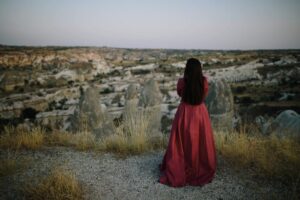Mural Brings Ethnic Studies to Life at Menlo-Atherton High School
Menlo-Atherton High School junior Celine Chien with the mural that she and muralist Jose Castro have been working on at the school in Atherton, on Tuesday, Aug. 15, 2023. Chien designed the mural, which was inspired by her ethnic studies class. (Dai Sugano/Bay Area News Group)
On the last day of summer break, Celine Chien stood by a giant wall at Menlo-Atherton High. Paintbrush in hand, the rising junior faced a half-finished mural three times her height — one Celine had designed after taking an ethnic studies class in ninth grade.
Representation and Activism
On one end, there was a group of Native Americans from the Ohlone tribe, the Bay Area’s original inhabitants. On the other, a group of high school students stood together, eyes toward the future. A series of characters filled the gaps in between, from immigrants sprinting toward the Gold Rush, to protesters brandishing Black Lives Matter signs. And toward the top right corner, a student held her fist in the air atop a pile of history books.
That’s ethnic studies in a nutshell, Celine says, referring to the course that examines history, power, and activism through the eyes of under-represented groups. Like dozens across the Bay Area, her high school adopted the course before a 2025 deadline when ethnic studies courses will be required for every high schooler in California. The Golden State is the first to mandate the course nationwide — but the adoption has been far from smooth.
Bay Area Leading the Way
“Across the country, ethnic studies is rare, and people of color are under-represented in textbooks,” said Mara Cavallaro, who graduated from Menlo-Atherton in 2018 and, two years later, helped bring ethnic studies to her alma mater. “It’s frustrating to have to prove or explain the value of ethnic studies and why students of color deserve to see themselves in the curriculum. That’s such a basic ask.”
In the Bay Area, many school districts have beaten the bill to the punch. Two years before the state deadline, 326 schools in the 10-county region are already offering ethnic studies courses that count toward a student’s requirements for admission to the University of California and California State University.
Increasing Enrollment and Impact
The San Francisco and Oakland Unified school districts were the earliest here to adopt the discipline, rolling it out in 2015 and 2016 respectively. It’s already mandated in the state’s largest districts, including Los Angeles, Fresno, and San Diego Unified. And from the 2015-16 academic year until the 2018-19 one, the number of students enrolled in ethnic studies courses jumped by 150% statewide.
“We get questions like, can I opt out of ethnic studies?” said Lailan Huen, who works in Oakland Unified’s Office of Equity. “You can go live in the mountains by yourself. But if you want to live in a place like Oakland — one of the most diverse cities in the world — then no. You cannot opt out of learning to navigate race, identity, and power.”
Decades of Advocacy
For decades, Huen has watched the ethnic studies debate unfold at her front door. The discipline was born just across the Bay Bridge, with San Francisco State’s Black Student Union leading the charge in 1968. Two decades later, Huen was a student at an Oakland Unified high school herself — and by 17, she was one of many pushing for ethnic studies in the district. But that didn’t happen until 2015, when Oakland Unified passed an ethnic studies policy and later rolled out the course districtwide.
“That really happened because of decades of students organizing in the school district, fighting for ethnic studies and pushing to see themselves reflected in their curriculum,” Huen said.
A Modern Movement
Five years later, students such as Cavallaro found themselves in a similar situation. By 2020, they were confronted by the police killings of Breonna Taylor and George Floyd, sparking the largest racial justice protests since the Civil Rights Movement. Cavallaro thought that maybe education could help us make sense of this moment.
“Ethnic studies demands that we talk about the histories of oppression and how they manifest today. Imagine living through the summer of 2020 and not knowing about that?” said Cavallaro.
Empowering Students
Despite the challenges, Menlo-Atherton High School has embraced ethnic studies. Ronnie Sanchez, Celine’s former ethnic studies teacher, explained the way his course works. First, he uses his students’ backgrounds to shape the course curriculum. Then they study migration and how each of the students’ families came to the Bay Area. After that, they move to power, dissecting racism, classism, and sexism. And then they focus on social movements, especially those that took place in the Bay Area.
Finally, students are asked to make a change of their own through a personal project — one that touches on anything from elevating students’ voices to confronting racism at their school. Celine created a program to channel students’ concerns to the Menlo-Atherton administration. Soon after, that project helped her become class president. And a year after that, she won a mural competition to bring the design she’d created in ethnic studies to life.
“Ethnic studies really allows us to open our minds and think about how we can solve the issues that we see,” said Celine.
Controversy and Progress
Despite its many benefits, ethnic studies is not universally accepted. Some school districts have faced criticism and lawsuits, alleging that their curriculums are anti-Semitic or divisive. There have also been debates over which groups should be included in the curriculum. These concerns were acknowledged when the state’s ethnic studies curriculum was revised to ensure a more balanced and inclusive approach.
In 2021, the revised model ethnic studies curriculum was approved, after five years and four drafts. If implemented correctly, it has the potential to increase awareness of the challenges faced by diverse communities and promote a deeper understanding of their histories beyond stereotypes.
“We want to use this as a learning opportunity,” said Adriana Lombard, the director of public education at the Jewish Community Relations Council of the Bay Area, which is working with districts to ensure bias-free curriculums. “To repair the harm that’s been done and build something stronger.”


